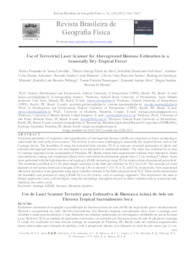Use of terrestrial laser scanner for aboveground biomass estimation in a seasonally dry tropical forest.
Use of terrestrial laser scanner for aboveground biomass estimation in a seasonally dry tropical forest.
Autoria: CARVALHO, H. F. de S.; SILVA, T. G. F. da; GALVINCIO, J. D.; ANTONIO, A. C. D.; MENEZES, R. S. C.; SANTOS, C. V. B. dos; MIRANDA, R. de Q.; NOBREGA, R. L. B.; DOMINGUES, T. F.; SILVA, E. A.; MOURA, M. S. B. de
Resumo: Structural parameters of vegetation and quantification of aboveground biomass (AGB) are important in forest monitoring to understand the vital cycle of ecosystems. This activity is even more challenging in seasonally dry tropical forests such as the Caatinga biome. The feasibility of using the terrestrial laser scanner (TLS) to measure structural parameters of plants and estimate aboveground biomass was investigated as an alternative to traditional methods. The study was conducted in an area of caatinga vegetation in the municipality of Petrolina, PE, Brazil, where three experimental subareas were selected to obtain measurements, cutting, and weighing of plants with a soil surface level diameter greater than 2.5 cm, totaling 97 plants. Scans were performed with the light detection and ranging (LiDAR) technology using TLS to obtain a three-dimensional point cloud. The correlation coefficient (r2) for plant height measured in the field and obtained by TLS was 0.80. The measures of trunk diameter at soil surfacelevel and at heights of 40 and 130 cm showed r2of 0.79, 0.78, and 0.76, respectively. New exponential allometric equations were generated using input variables obtained in the field and point cloud TLS. These results demonstrate the feasibility and potential of using LiDAR-TLS in dry forests, such as caatinga vegetation. This emphasizes the need to deepen approaches, tools, and techniques using this technology throughout the year to detect variations due to senescence and, therefore, the carbon cycle
Ano de publicação: 2023
Tipo de publicação: Artigo de periódico
Unidade: Embrapa Semiárido
Palavras-chave: Biomassa, Caatinga, Floresta Tropical, Florestas tropicais sazonalmente secas, Laser scanner, Solo, Vegetação
Observações
1 - Por padrão são exibidas publicações dos últimos 20 anos. Para encontrar publicações mais antigas, configure o filtro ano de publicação, colocando o ano a partir do qual você deseja encontrar publicações. O filtro está na coluna da esquerda na busca acima.
2 - Para ler algumas publicações da Embrapa (apenas as que estão em formato ePub), é necessário ter, no celular ou computador, um desses softwares gratuitos. Sistemas Android: Google Play Livros; IOS: iBooks; Windows e Linux: software Calibre.
Acesse outras publicações
Acesse a Base de Dados da Pesquisa Agropecuária (BDPA) para consultar o acervo completo das bibliotecas da Embrapa.

